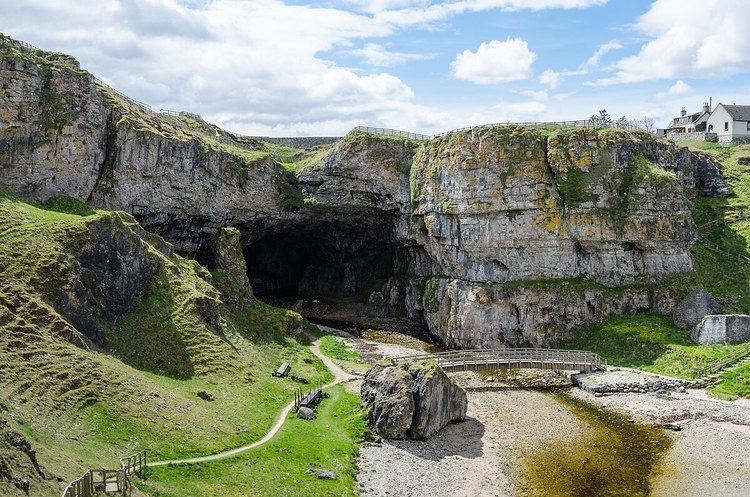Phone +44 1971 511259 | ||
 | ||
Similar Cape Wrath, Faraid Head, Dunrobin Castle, Dunnet Head, Fingal's Cave | ||
Smoo Cave is a large combined sea cave and freshwater cave in Durness in Sutherland, Highland, Scotland.
Contents
Smoo cave durness
Geology
Smoo Cave was formed within Early Ordovician dolostones of the Durness Group (also known as the Durness Limestone). The cave has formed along the boundary between the light grey Sangomore Formation and the dark grey, mottled Sailmhor Formation (sometimes called Leopard Rock), both of which form part the Durness Group succession. These horizons close to the formation boundary are characterised by large and abundant chert nodules which can be found all along the inner stream chamber where they have been left behind after dissolution of the surrounding dolostone. The cave was formed along two geological lines of weakness by a combination of erosion from the sea and an inland underground stream which has formed the innermost chambers. Upstream of the Allt Smoo which runs into the cave, impermeable quartzites have been faulted against the Durness Limestone, causing the stream to sink down into the carbonate rock soon after it has crossed the contact between the two different rock types.
Physical description
The cave is unique within the UK in that the first chamber has been formed by the action of the sea, whereas the inner chambers are freshwater passages, formed from rainwater dissolving the carbonate dolostones. Partway through the cave the waters of Allt Smoo also drop in as a 20m high waterfall. This is mainly due to the nearby dolostone - quartzite geological boundary where the Allt Smoo stream crosses the impermeable quartzites and sinks on meeting the permeable dolostones. Essentially the cave can be thought of as two caves formed by different mechanisms which have joined together over time. The cave is composed of three main sections; a large sea cave entrance chamber, a waterfall chamber and a short freshwater passage which leads to a terminal sump chamber with some interesting flowstone formations at the rear.
The cave entrance and main chamber have been considerably enlarged by sea action to approximately 40m wide and 15m high, the largest sea cave entrance in Britain. The entrance is located at the end of a 600m long tidal gorge (Geodha Smoo) which was once part of the cave, now collapsed. Several remnant pillars can be seen along the eastern side of the Geodh along with a large section of the previous roof which has been partly buried by the grassy slope (normally covered by rocks spelling out the names of visitors to the cave). Interestingly, the sea rarely enters the sea cave nowadays (only during spring tides) as the area has undergone isostatic uplift.
The present-day cave is 83m long up to the terminal sump at the rear of the third chamber / passage. The cave travels further however as an active stream of notable size resurges here at all times. Previous dye-testing has linked an underwater passage to an initial sink point in the Allt Smoo stream about 100m upstream from the main waterfall, implying that the cave system is at least twice as long as once thought. Cave divers belonging to the Grampian Speleological Group have dived this sump to a distance of c. 40m, although large volumes of silt and peat in the water have prevented further exploration. It is worth noting that the main waterfall is often dry and will only become active once this upstream sink overflows.
Archaeological investigations have turned up Neolithic, Norse and Iron Age artifacts, and it is thought that usage may extend back to the Mesolithic age. The cave name is thought to originate from the Norse 'smjugg' or 'smuga' meaning a hole or hiding-place.
Tourism
The cave is located 2 km east of the village of Durness and is presently served by a car park, toilets, stairs and walkways. Plans are being considered for access improvements for the estimated 40,000 visitors it receives annually. Tours of the cave also operate during summer months, taking visitors to the inner chamber by boat.
